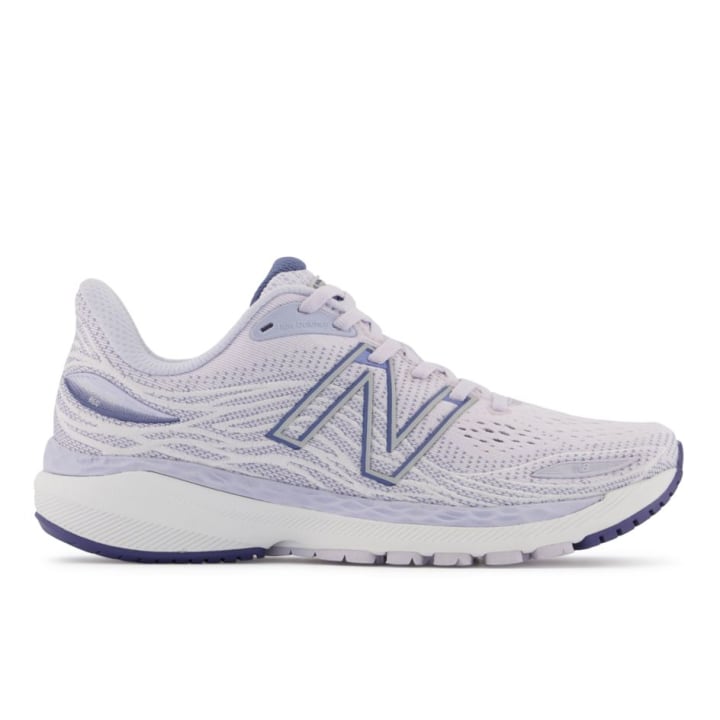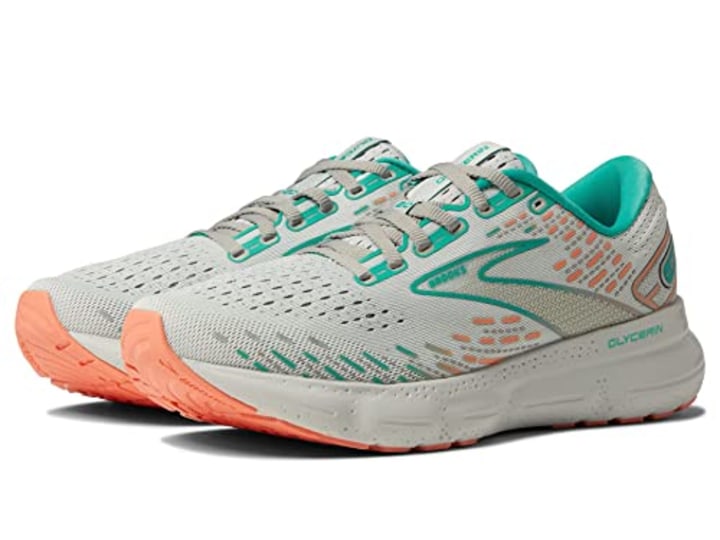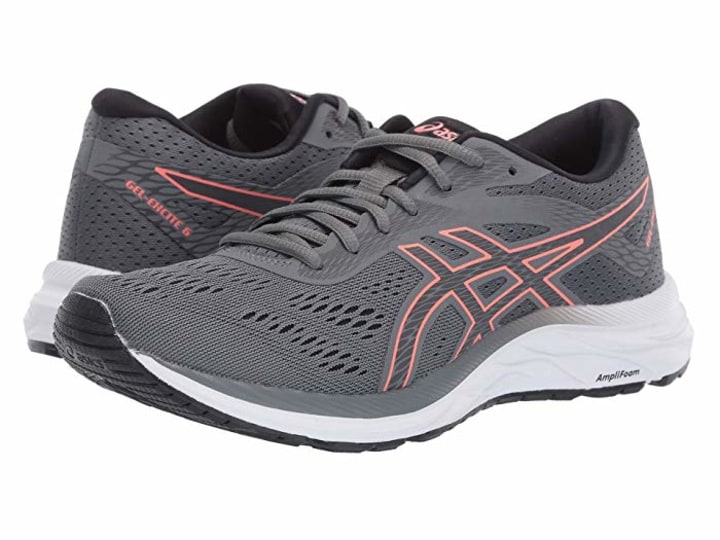11 best walking shoes for women in April 2023
Whether you work out at the gym, run your kids to and from school or commute by foot, getting daily exercise is essential to both physical and mental health. However, considering the aching soles, toe cramps, or heel pain that may come with daily movement, it’s understandable why some may avoid it. Thankfully, a good pair of shoes can help. And you don’t need separate sneakers for walking and running — Miguel Cunha, podiatrist and founder of Gotham Footcare in New York, said that any good running shoe is also a great walking shoe.
LEARN MORE Best walking shoes for women | Identifying your foot type | Getting fitted for sneakers | Do you need orthotics in your sneakers? | How to break in your new walking shoes
Our Top Picks
How we picked the best walking shoes
We talked with podiatrists to find out what to look for in a good pair of walking shoes and what to expect when getting fitted for sneakers. They also explained the best ways to break in a new pair of sneakers and highlighted some of their favorite pairs. They said we should look at the following:
- Material: Anti-compression insoles with memory foam and rubber outsoles will make the impact of your step feel better on your body.
- Fit: Shoes need to fit your foot and also need to work with the bend of your foot, which is also called the flex point.
Best walking shoes for women in April 2023
Whether you are an avid long-distance power walker, love to hit the trails or simply want the best shoe for cruising around town, it’s important to find the right shoe to fit your lifestyle and your foot type. We’ve asked our experts to share their top picks that offer supreme comfort, extra cushioning and superior arch support to keep your feet feeling their best.
Hoka One One Bondi SR
Recommended by Cunha, this sneaker is the most cushioned of the Hoka road shoe lineup, according to the brand. Its leather is water-resistant, and it has a slip-resistant outsole and EVA midsole. It can stand up to the demands of an all-day service job, says Hoka, because of its extra cushioning and its rubber sole that hugs the ground.
On Cloud 5
This hybrid lifestyle/running shoe is another favorite of Cunha’s, for its ability to absorb impact and provide a cushioned landing. The On Cloud 5 is super lightweight and has a textile and synthetic upper for maximum breathability, says the brand. It also has a removable insole and rubber sole.
New Balance FuelCell SuperComp Pacer
Cunha said he recommends this shoe to all his patients because of the carbon fiber plate embedded in its midsole that absorbs the impact of a heel strike. “It helps propel your foot by pushing that force back onto the ground, allowing you to run longer and faster,” he said, adding that it’s also lightweight and durable.
Ryka Women’s Devotion Plus 2 Walking Shoe
These walking shoes from Ryka are lightweight, breathable and not too bulky, according to the brand. “This is a newer shoe that people are loving,” said Shvets. “They have a very substantial bottom that helps with impact — very similar to Saucony and ASICS.”
New Balance Women’s 860v12
This shoe would be considered a stability sneaker — meaning it’s best for runners with normal arches and only mild control problems — and can be identified by the medial side of the shoe where you see the marbleizing. Shvets likes this shoe because it provides more comfort than typical walking shoes due to the additional cushioning that helps absorb the impact and protects the joints. These shoes can also accommodate orthotics comfortably. “They are great for the elderly population,” said Shvets. In addition to being lightweight, the shoe has extra cushioning for comfort and support and is made with durable synthetic material for long-term use.
Brooks Adrenaline GTS 22
The Adrenaline GTS uses a GuideRail system that balances the foot back into position by providing passive stability. “If you talk to any marathon runner, they are picking Brooks because there is a lot less injury,” said Shvets, adding that this sneaker has a good heel counter, which provides stability to the foot and gives the shoe longevity. “It’s really durable,” she noted.
Saucony Integrity Walker 3
“I highly recommend [Saucony] for neutral-arched or low-arched people,” Cunha said. “They provide great stability and have extra padding for shock control.” Shvets agreed: “This shoe is really great for an overpronator because it offers a lot of support,” she noted. The Integrity Walker 3 has the American Podiatric Medical Association seal of approval — the organization says shoes that are APMA-approved have been “found to promote good foot health.”
FitFlop Lulu Flip Flops
A Schvets favorite for walking and another walking shoe with the APMA seal of acceptance, the FitFlop is a comfortable shoe that offers built-in arch support. “When people wear pancake flip flops, they are more prone to injury,” she said. “If they want something more fashionable but don’t want to wear a sneaker, these are great.” Birkenstock and Vionics are also among her favorite walking shoes.
Saucony Guide 15
The newly designed Guide 15 offers a softer, more cushiony feel, according to Cunha. “I always recommend this shoe because it delivers a softer heel strike and takes some stress off the foot,” he said.
Brooks Glycerin 20
If you have a wide toe box or if bunions or hammertoes are an issue, Cunha recommended the highly cushioned Glycerin 20. “It gives you more life than New Balance because it’s more durable. And it’s great for people with wide feet,” he said.
ASICS Women’s GEL-Excite 6 Running Shoes
If you had a foot diagnostic test at a running store that determined you have flat feet, Shvets said this lightweight shoe is a great option because of its high arch. It’s also extremely breathable, she added.
What to look for when shopping for walking shoes
If you plan to go to the store to get fitted, Cunha said it’s best to do so at a specialty running store, where the staff is better informed and knowledgeable about shoe choices and recommendations. “They will have more time to spend with you individually,” he said. (More on this below) Cunha also suggests shopping in the evening, since that’s when your feet are most swollen. “If the shoe feels comfortable at the end of the day, it will most likely feel comfortable throughout the day,” he noted. Here are four other important factors to consider when shopping for a new pair of shoes.
An anti-compression insole. Cunha said it’s important to look for a footbed with memory foam or an ethyl vinyl acetate (EVA) anti-compression insole for added comfort to support the arch.
A rubber outsole. A shock-absorbent outsole made of rubber will help alleviate the impact of each step far greater than a shoe with a hard sole, said Cunha.
Smooth, solid uppers. The upper part of the footwear that covers the top of the foot and attaches to the sole should not only be highly durable but also flexible and comfortable, said Cunha.
Flex point. For optimal comfort, the flex point of the shoe — which is the point at which it bends while walking — should match the bending point of your foot; when it doesn’t align with your foot, it can cause problems like arch pain or plantar fasciitis, said our experts. You can check the flex point of the shoe by holding it by the heel and pressing the toe of the shoe onto the ground — the point where the shoe bends and creases is the flex point. Olga Shvets, a podiatrist at Central Park Podiatry in Yonkers and Bay Ridge Family Podiatry in Brooklyn, added that most runners and walkers can benefit from a shoe with a stiff sole that doesn’t bend in half.
Your arch – whether neutral, low or high–determines the direction and severity of the way your foot rolls, or pronates. “You can identify your [foot type] by paying attention to which part of your foot hits the ground first,” said Shvets. She recommended looking at the soles of a well-worn pair of sneakers to see where they are worn out, as this will indicate where you are making most of your impact and thus indicate whether your foot type is a pronator, supinator or neutral. Below is a more detailed description of the three types of feet. Knowing which type you have is the first step when it comes to buying the right sneaker or walking shoe. Here is what
- Pronator: When your ankle or arch rolls or tips inward slightly, you are dealing with pronation. When the foot rolls too far inward toward the arch, it is referred to as overpronation. This gait can cause flat feet, which is when there is little to no arch in the feet. Some people are born with this condition; other times it is a result of an injury to the ligament or tendon, causing the arch to collapse. Those with pronation and flat feet will see worn tread in the middle of the heel and toward the inner edge of the heel. Cunha said a shoe with a supportive sole and a firm but cushioned insole is best for overpronators.
- Supinator: When your weight rolls onto the outer edges of your feet, you are dealing with supination. Supinators will see a worn tread on the outer edge of the heel and should look for added cushioning at the heels.
- Neutral: If your foot lands on your heel and rolls forward during the gait cycle so that the impact is distributed evenly across the forefoot, you have a neutral gait. Those with a neutral gait will see the most wear at the heel, as well as below the first and second toe.
Getting fitted for sneakers: What to expect
Cunha said it’s important to remember that sizing can be different across brands due to design and the materials used. “I never recommend buying any sneaker online unless you’ve had it fitted in a store,” he said. Also keep in mind that the length and width of your foot tends to change over time due to falling arches or hormonal changes that occur if you get pregnant.
The tip of your thumb should fit between the front of the shoe and the end of your longest toe. Make sure the toe box is wide enough to accommodate your toes — there should be enough room to slightly wiggle your toes. Try at least three different shoe models — try two different models at the same time, wearing one model on each foot, to better compare.
Jesus Esparza, a fit expert at Road Runner Sports in Sterling, Virginia, said that when someone comes in looking for a more comfortable shoe or better support, the first thing he does is ask them to step out of their shoes. “I look specifically at their gait. I look at their arch type and their posture. When they are standing still, I look to see if they are leaning in or out,” he said. He then analyzes their movement as they run on a treadmill and uses a 3D scanner to take critical measurements of their foot. When the data from the body in motion is combined with data from the foot scanner, he is able to really dial in on the style and shape of a shoe that will work best.
Esparza said he sees a lot of people come in with bunions and plantar fasciitis, both of which he said can be avoided with shoes that fit properly. Tightly fitting sneakers, he noted, can cause bunions on the sides of the feet or on the middle toe, for instance.
“Many people think that their foot size is their shoe size. People come in wearing an 8.5 because that’s their foot size, but we have to convince them that their shoe size is really a 9,” he said. “Others have no idea they have a wide foot. For runners or active people, we try to tell them they need their space so their toes can breathe.”
Another misconception, he said, is that every sneaker has built-in arch support. “That is not always the case. Most times you should have an [orthotic] insole” to offer extra support. Cunha agreed, noting that while custom is always best, any shoe you buy off the shelf should have an anatomical arch embedded into it to absorb the shock and take stress away from the plantar fascia. “Brooks, New Balance, Saucony, ASICS and Hoka are all designed with [this arch support],” he noted.
If you have any concerns about your foot shape or injuries like plantar fasciitis, getting fitted by a professional is a smart option. If you are unable to visit a store at this time, you may also have the opportunity to speak to a professional on the company website via chat.
Orthotics: Do you need them in your sneakers?
Our experts agreed that most people can benefit from a pair of orthotics — inserts that offer custom support to alleviate pain or discomfort and ensure you’re maintaining proper alignment.
“Although orthotics are of greater importance for people that suffer from flat feet, everyone — regardless of their foot type — can benefit from orthotics, as they help redistribute weight evenly across your feet,” Cunha said. “Although I prefer custom foot orthotics over prefabricated insoles, some health insurance companies do not provide coverage for custom orthotics and they can be expensive when paying out of pocket.” If custom orthotics aren’t an option, he recommended buying a good insole such as PROFOOT Triad Orthotics, Superfeet, or Pure Stride.
Shvets said to be careful when buying over-the-counter orthotics. “Most drugstores sell cushion orthotics that fold and roll — they don’t offer support and are basically a pillow for your feet,” she noted. She prefers a stiffer insert, which generally isn’t available in the average drugstore. Her favorites: Spenco, Profoot and Orthofeet. “You can buy these online. They make a not-so-great-shoe into a much better shoe,” she said.
How to break in your new sneakers and walking shoes
Cunha noted that while there is a natural break-in period during which the shoes will give and accommodate your feet more, shoes should still feel comfortable when you first try them. If they hurt at all upon try-on, consider a different pair. Once you decide on the shoe that’s right for you, here are a few tips for breaking them in:
Wear them in increments. For the first four days, wear your new shoes for two hours the first day, four hours the second day and so on. Then, on the fifth day, wear your shoes all day. This allows the shoe to expand gradually while minimizing any pressure or friction that might otherwise cause pain, swelling, calluses and blisters.
Take it slow. If you are completely new to walking as a form of exercise, then make it a goal for the first week to walk three times in 15-minute increments. During the second week, add in a fourth day, and pick two of the days to add in some hills or intervals. You could walk for one block at your comfortable pace and then the next block at a faster pace, or if you’re on the treadmill, walk for one minute with no incline and then increase the incline to 3 for the next minute, and continue alternating.
Form is key. Cunha said that when walking, you should take a comfortably natural step that is not too long in stride so that when your foot strikes the ground, you are striking less through the heel and more through your midfoot or forefoot. “Also make sure you unlock one knee prior to striking the foot down and that your hips are over the foot at foot strike and not behind it,” he said. This can take a lot of self-analysis, but a specialist can help you break this down if you visit a running store.
Meet our experts
At Select, we work with experts who have specialized knowledge and authority based on relevant training and/or experience. We also take steps to ensure that all expert advice and recommendations are made independently and with no undisclosed financial conflicts of interest.
- Miguel Cunha is a podiatrist and founder of Gotham Footcare in New York.
- Olga Shvets is a podiatrist at Bay Ridge Family Podiatry in Brooklyn .and Central Park Podiatry in Yonkers.
- Jesus Esparza is a fit expert at Road Runner Sports in Sterling, Virginia.
Catch up on Select’s in-depth coverage of personal finance, tech and tools, wellness and more, and follow us on Facebook, Instagram and Twitter to stay up to date.











